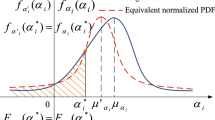Abstract
This paper presents an effective method for solving stochastic problems commonly encountered in structural engineering and applied mechanics. Design of experiments is conducted to obtain the response values of interest, where Chebyshev nodes are applied to collect discrete samples. Then Chebyshev polynomials are applied to approximate the univariate functional relationship between each variable and the structural response. The univariate dimension reduction method and saddlepoint approximation with truncated cumulant generating functions are employed to estimate the statistic cumulants, probability density function and cumulative distribution function of the response. The results of numerical examples indicate that the proposed approach provides accurate, convergent, and computationally efficient estimates of the probabilistic characteristics of random mathematical functions or the responses of structural systems.
















Similar content being viewed by others
References
Butler RW (2007) Saddlepoint approximations with applications. Cambridge University Press, New York
Choi J, An D, Won J (2010) Bayesian approach for structural reliability analysis and optimization using Kriging dimension reduction method. ASME J Mech Des 132(5):051003
Daniels HE (1954) Saddlepoint approximations in statistics. Ann Math Stat 25(4):631–650
Du X (2008) Saddlepoint approximation for sequential optimization and reliability analysis. ASME J Mech Des 130(1):011011
Du X (2010) System reliability analysis with saddlepoint approximation. Struct Multidiscipl Optim 42(2):193–208
Du XP, Chen W (2001) A most probable point based method for uncertainty analysis. J Design Manuf Autom 4(1):47–66
Du X, Sudjianto A (2004) The first order saddlepoint approximation for reliability analysis. AIAA J 42(6):1199–1207
Easton GS, Ronchetti E (1986) General saddlepoint approximations with applications to L statistics. J Am Stat Assoc 81:321–337
Engelund S, Rackwitz R (1993) A benchmark study on importance sampling techniques in structural reliability. Struct Saf 4(12):255–276
Gillespie CS, Renshaw E (2007) An improved saddlepoint approximation. Math Biosci 208(2):359–374
Haldar A, Mahadevan S (2000) Probability, reliability and statistical methods in engineering design. Wiley, New York
Hohenbichler M, Gollwitzer S, Kruse W et al (1987) New light on first- and second-order reliability methods. Struct Saf 4(4):267–284
Huang BQ, Du XP (2006) Uncertainty analysis by dimension reduction integration and saddlepoint approximations. ASME J Mech Des 128(1):26–33
Huang B, Du X (2008) Probabilistic uncertainty analysis by mean-value first order saddlepoint approximation. Reliab Eng Syst Saf 93(2):325–336
Kiureghian AD (2008) Analysis of structural reliability under parameter uncertainties. Probab Eng Mech 23(4):351–358
Laumakis PJ, Harlow G (2002) Structural reliability and Monte Carlo simulation. Int J Math Educ Sci Technol 33(3):377–387
Lee SH, Chen W (2009) A comparative study of uncertainty propagation methods for black-box-type problems. Struct Multidiscipl Optim 37(3):239–253
Lee I, Choi KK, Du L et al (2008) Dimension reduction method for reliability-based robust design optimization. Comput Struct 86(13–14):1550–1562
Lee I, Choi KK, Gorsich D (2010) Sensitivity analyses of FORM-based and DRM-based performance measure approach (PMA) for reliability-based design optimization (RBDO). Int J Numer Methods Eng 82(1):26–46
Li J, Chen JB (2009) Stochastic dynamics of structures. Wiley, Singapore
Lugannani R, Rice SO (1980) Saddlepoint approximation for the distribution of the sum of independent random variables. Adv Appl Probab 12:475–490
Mason JC, Handscomb DC (2003) Chebyshev polynomials. Champman & Hall, New York
Mathews JH, Fink KD (2004) Numerical methods using MATLAB, 4th edn. Prentice-Hall, Upper Saddle River
Melchers RE, Ahammed M (2004) A fast approximate method for parameter sensitivity estimation in Monte Carlo structural reliability. Comput Struct 82(1):55–61
Pellissetti MF, Schuëller GI, Pradlwarter HJ, Calvi A, Fransen S, Klein M (2006) Reliability analysis of spacecraft structures under static and dynamic loading. Comput Struct 84(21):1313–1325
Picheny V, Kim NH, Haftka RT (2010) Application of bootstrap method in conservative estimation of reliability with limited samples. Struct Multidiscipl Optim 41(2):205–217
Rahman S, Xu H (2004) A univariate dimension-reduction method for multi-dimensional integration in stochastic mechanics. Probab Eng Mech 19(4):393–408
Resenblueth E (1981) Two-point estimates in probabilities. Appl Math Model 5(5):329–335
Rosenblatt M (1952) Remarks on a multivariate transformation. Ann Math Stat 23(3):470–472
Smyth GK, Podlich HM (2002) An improved saddlepoint approximation based on the negative binomial distribution for the general birth process. Comput Stat 17(1):17–27
Süli E, Mayers DF (2003) An introduction to numerical analysis. Cambridge University Press, New York
Wang S (1992) General saddlepoint approximations in the bootstrap. Probab Stat Lett 13(1):61–66
Wang L, Beeson D, Wiggs G (2004) Efficient and accurate point estimate method for moments and probability distributions. Proc. 10th AIAA/ISSMO Multidisciplinary analysis and optimization conference, Albany, NY, August 30–September 1, AIAA 2004–4359
Wei D, Rahman S (2007) Structural reliability analysis by univariate decomposition and numerical integration. Probab Eng Mech 22(1):27–38
Xu H, Rahman S (2004) A generalized dimension-reduction method for multidimensional integration in stochastic mechanics. Int J Numer Methods Eng 61(12):1992–2019
Xu H, Rahman S (2005) Decomposition methods for structural reliability analysis. Probab Eng Mech 20(3):239–250
Youn BD, Xi ZM (2009) Reliability-based robust design optimization using the eigenvector dimension reduction (EDR) method. Struct Multidiscipl Optim 37(5):475–492
Youn BD, Choi KK, Du L (2005) Adaptive probability analysis using an enhanced hybrid mean value method. Struct Multidiscipl Optim 29(2):134–148
Youn BD, Xi ZM, Wang PF (2008) Eigenvector dimension reduction method for sensitivity-free probability analysis. Struct Multidiscipl Optim 37(1):13–28
Zhang YM, Chen SH, Liu QL, Liu TQ (1996) Stochastic perturbation finite elements. Comput Struct 59(3):425–429
Zhao YG, Ono T (2000) New point estimates for probability moments. J Eng Mech 126(4):433–436
Acknowledgements
The authors gratefully acknowledge the support of Fundamental Research Funds for the Central Universities No. N090603002, Key National Science & Technology Special Project on “High-Grade CNC Machine Tools and Basic Manufacturing Equipment” No. 2010ZX04014-014 and and Program for Changjiang Scholars and Innovative Research Team in University No. IRT0816. Moreover, all comments and suggestions from editors and reviewers are gratefully acknowledged.
Author information
Authors and Affiliations
Corresponding author
Rights and permissions
About this article
Cite this article
Huang, X., Zhang, Y., Jin, Y. et al. An improved decomposition method in probabilistic analysis using Chebyshev approximations. Struct Multidisc Optim 43, 785–797 (2011). https://doi.org/10.1007/s00158-010-0606-7
Received:
Revised:
Accepted:
Published:
Issue Date:
DOI: https://doi.org/10.1007/s00158-010-0606-7




